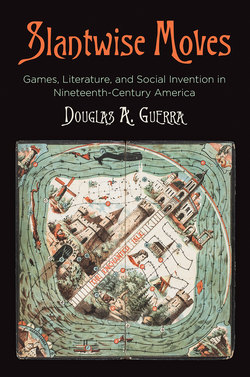Slantwise Moves

Реклама. ООО «ЛитРес», ИНН: 7719571260.
Оглавление
Douglas A. Guerra. Slantwise Moves
Отрывок из книги
Slantwise Moves
Series Editors
.....
Examining the figures and forms of mid-nineteenth-century games in the United States allows us to understand literature in conversation with a complex and evolving commercial marketplace of things, a conversation that facilitates one of literature’s core functions as historical repository. To find meaning in literary objects, critical scholarship must reconstruct the social environments that allow(ed) them to signify; yet it has often proven difficult to track a set of associations that are based on motion and spatiality and operational possibility using what are assumed to be nonprocedural forms (that is, novels, poems, autobiographies). As a result, critical methodologies fixate on the immobile, the institutional, and a historiography of increasingly obliterated time. These perspectives are crucial, and yet they risk leaving out the temporal local activities of daily life that are enacted and reiterated by gameplay and reading. Here timing, movement, and sociality were always, and often explicitly, at issue. For those seeking a deeper understanding of the interactive medial shift that was occurring across the nineteenth century—corresponding to a shift in the possibilities of the literary—games offer models of emerging procedural grammars, drawing attention to the increasingly algorithmic structures enabling the civic agencies that have been represented by American literary studies. The consequence of pairing games and literature allows us (to repurpose a phrase used by Gerry Canavan and Priscilla Wald) “to track both a shift in the formative terms of an ideology and the means by which that shift occurs.”63 In short, it allows us to create new ways of reading and to imagine old ways of playing that have important bearing on literary history, as well as literary critical practice and pedagogy.
Moreover, Emerson’s image evokes a transposability not present in the earlier metaphor. By thinking of the self as a mold, one is encouraged to imagine multiple wax productions yielded from the same basic structure, each one slightly different in terms of the raw material furnished (the “circumstances” the world presents) but proximately linked via the mold’s underlying shape. Here one might think of the ever-changing states presented by a moderately open-ended game like Life: each turn instances a new circumstance, new raw materials for testing the desirability of the current expressive strategy or mold. Bradley hoped these habits of judgment would not only be “forcibly impressed” on the character of the game’s players within the game but also capable of being ported to a real-world perspective on self.72
.....